It wasn’t until I started landscaping our new yard from scratch that I realized ground covers can go far beyond the ice plants, lawns, and plain old bark mulch I’m used to seeing.
There is simply a ground cover for every situation: hot and sunny xeriscape gardens, harsh winter climates, poor and rocky soils, and even ground covers that thrive in shade. You’ll find endless options depending on what you want your ground cover to do (besides covering the ground, that is).
Do you want a pretty flowering carpet that attracts bees and other pollinators? Or something stout and sturdy for erosion control? Do you want a resilient ground cover you can walk on, or a more ornamental shrub to decorate a front yard?
Maybe you’re looking for a plant that can fill in a landscape and give year-round beauty and color—in which case, an evergreen ground cover is exactly what you need.
Do evergreen ground covers actually stay green in winter?
While my list below is categorized by USDA hardiness zones, whether or not a ground cover actually remains evergreen will highly depend on the winter temperatures and snow cover in your yard. Sometimes, very cold temps combined with a lack of snow cover (which insulates the plant) will cause the ground cover to turn brown or even die back to the ground.
This usually isn’t a problem if the plant is hardy to your zone; once spring arrives, new green growth should emerge.
Disclosure: If you shop from my article or make a purchase through one of my links, I may receive commissions on some of the products I recommend.
Where to buy
Evergreen ground covers
What about invasive ground covers?
Certain ground covers may be considered invasive in parts of the country (and I do make note of this for specific plants on my list).
But when you think about it, ground covers—by their very nature—like to spread. Sometimes aggressively. They wouldn’t be very good ground covers if they didn’t cover more ground, right?
Though they excel at blanketing the soil, suppressing weeds, and providing habitat for beneficial insects, some ground covers also have a tendency to escape a little too freely beyond their original planting area. You might want this in a walkway or a wild lawn, but if your goal is to neatly fill in the spaces between other landscaping plants, you’ll need to take measures to keep your ground cover contained.
When choosing ground covers, I often recommend going for plants that are one zone colder than your own. This makes it more likely they’ll actually stay evergreen! With that said, let’s start with my favorite options for colder zones…
Zones 3 and above
Candytuft (Iberis sempervirens)
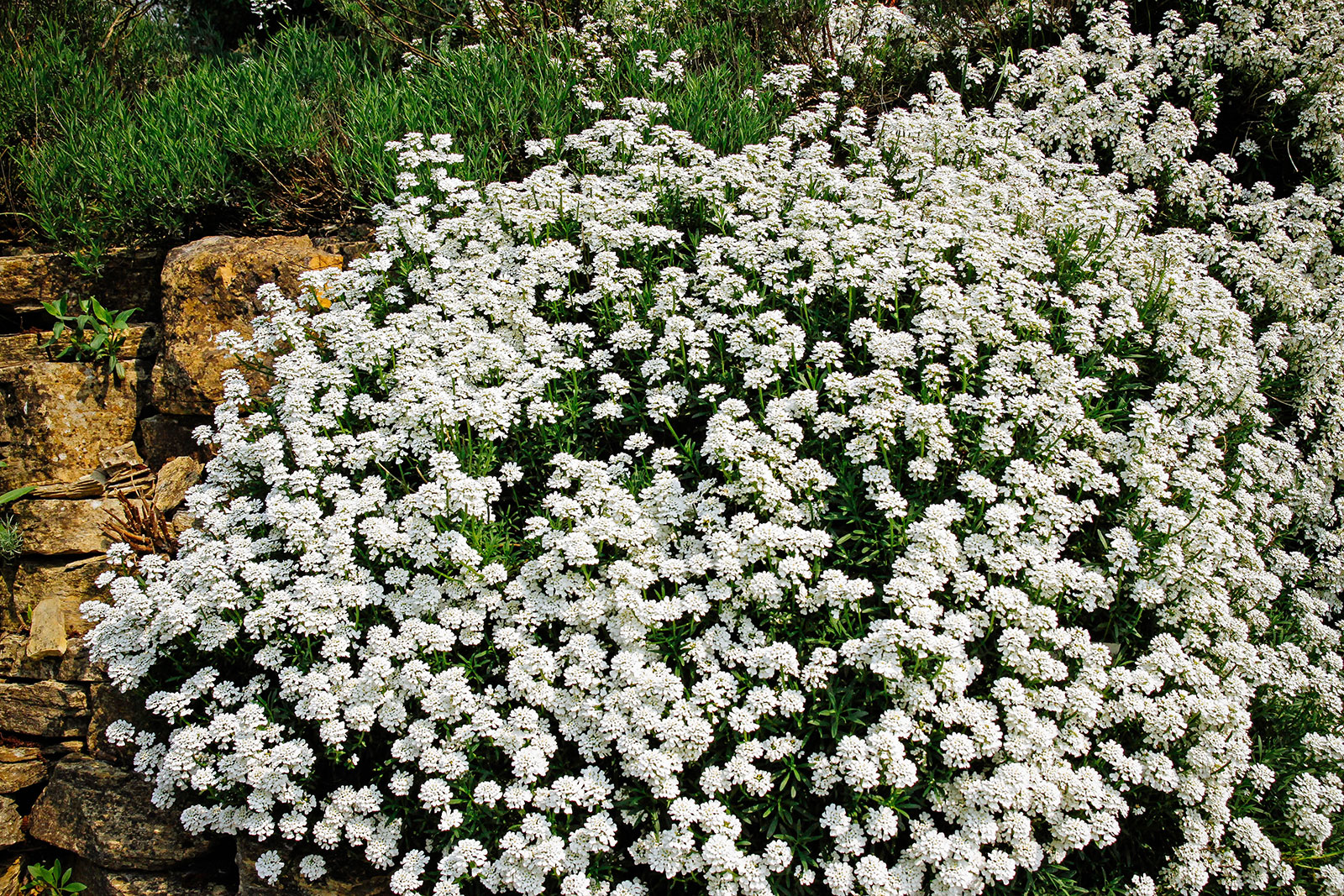
Originally from Europe and part of the cabbage family Brassicaceae, candytuft (Iberis sempervirens) is popular worldwide as a groundcover plant thanks to its pretty white flowers and forgiving nature. It’s a woody shrub that grows around 16 inches tall and wide.
Because it naturally grows in steppe-type landscapes, candytuft prefers well-draining soil and not too much humidity. It prefers regular watering, but won’t kick the bucket if you forget about it for a few weeks.
You can plant your candytuft shrubs in full sun to half shade. If you’re not a fan of white flowers, go for cultivars like ‘Pink Ice’ or ‘Mermaid Lavender’. There are plenty to choose from!
- Soil type: Well-draining
- Light level: Full sun to partial shade
- Water: Keep lightly moist
- Withstands foot traffic? No
Creeping juniper (Juniperus horizontalis)
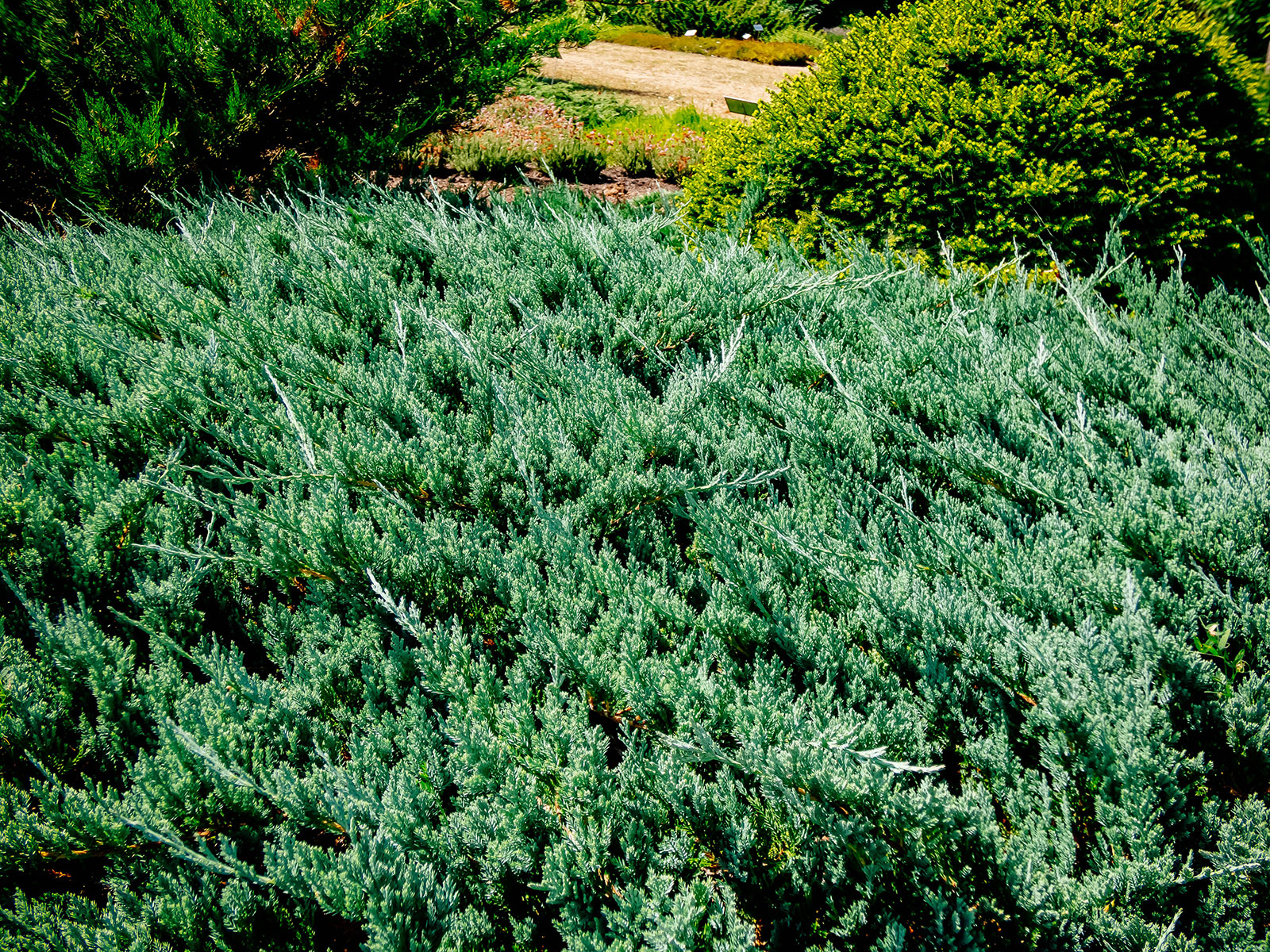
Looking for a seriously tough groundcover plant that can grow where many other species can’t? Creeping juniper is naturally found in rather harsh habitats in the northern USA and Canada, and has evolved to be very hardy. It’s commonly used for erosion control on sloped surfaces.
Drought, rocky soil, hot weather, and harsh sun don’t bother creeping juniper, and the plant is pretty resistant to deer and other herbivores. As a bonus, its blue-green foliage is attractive and releases a pleasant smell when disturbed (like when you walk over it, which you can do semi-regularly without issue).
Related: More walkable ground covers to consider for your yard
Creeping juniper grows to a maximum height of around 3 feet and can spread 15 feet or more, making it a good option if you need to cover a large area. There are several cultivars available, including the extra-low ‘Pancake’ and the variegated ‘Andorra Variegata’.
- Soil type: Well-draining
- Light level: Full sun
- Water: Keep lightly moist
- Withstands foot traffic? Yes, if it’s not daily
Creeping speedwell (Veronica repens)
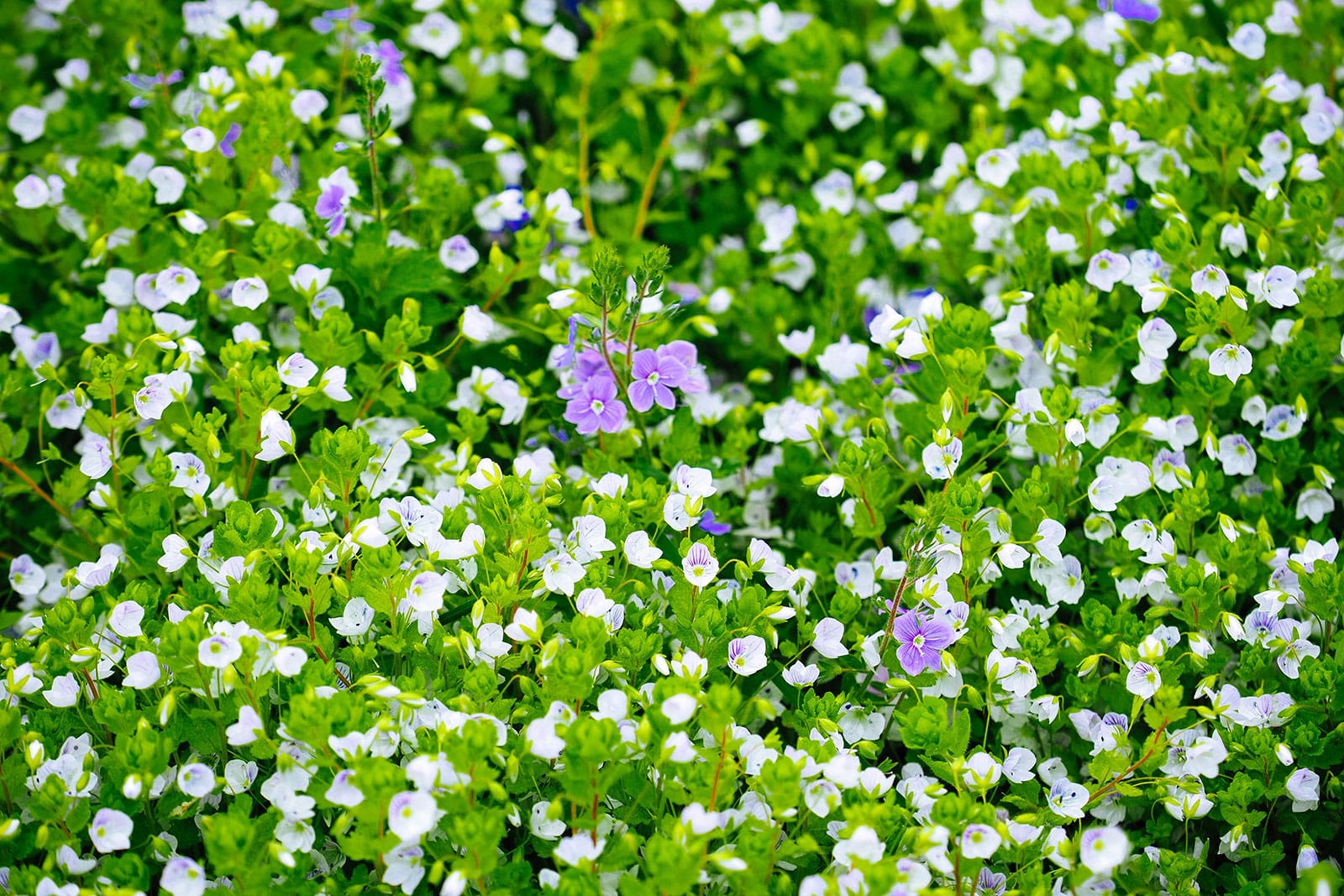
Despite its dainty looks, this super low-growing carpet of tiny, scallop-shaped leaves is actually pretty resilient and can take a little foot traffic. It helps that the plant grows to only 2 inches high, but spreads (via underground stolons) about 12 inches wide.
This is the kind of ground-hugger you want for filling in the spaces between flagstone, along borders, and in rock gardens, or growing as a living mulch in perennial beds, as it can help suppress early spring weeds when tulips and daffodils are coming up.
In late spring, the green foliage is studded with singular flowers ranging from white to lavender to blue. Deer and rabbits leave it alone, so you can plant creeping speedwell in tricky spots where other ground covers tend to get snacked. It’s easy to propagate: simply dig up a small section, divide it and replant elsewhere in fall or spring.
- Soil type: All types, including poor, rocky soils
- Light level: Full sun to partial shade
- Water: Keep lightly moist
- Withstands foot traffic? Yes, light to moderate
Bird’s nest spruce (Picea abies ‘Nidiformis’)
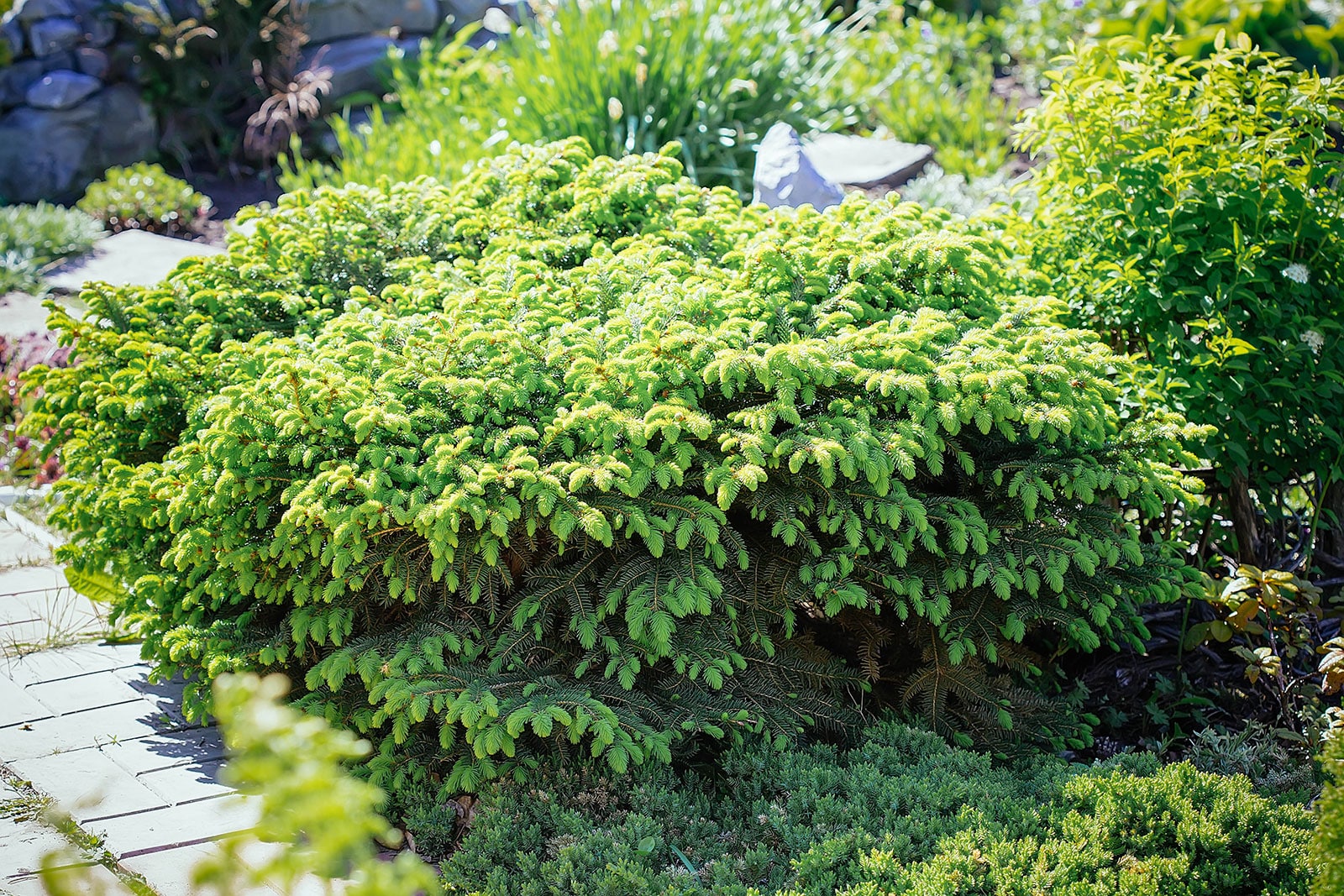
Another conifer, the bird’s nest spruce is a low-growing, shrubby cultivar of Picea abies: the ubiquitous Norway spruce, which normally grows very tall. Known as Picea abies ‘Nidiformis’ (which means nest-shaped), it reaches no more than around 4 feet in height and has a round growth pattern that does make it look distinctly “nesty”.
Bird’s nest spruce is a good option if you don’t mind a slightly taller groundcover and are looking for something that’s easy to keep alive. It likes slightly acidic, gritty soil but isn’t too bothered about its growing medium. It can do well in both full sun and dappled shade, and deer don’t like the taste.
Keep in mind that this is a slow grower, especially if you grow it in a more shaded spot. It’s not a huge fan of heat and drought, preferring cool climates similar to its natural habitat of northern Europe.
- Soil type: Well-draining, acidic to neutral
- Light level: Full sun to partial shade
- Water: Keep lightly moist
- Withstands foot traffic? No
Bugleweed (Ajuga reptans)

If you love flowers, maybe bugleweed (Ajuga reptans) is the right groundcover for you. An edible member of the mint family and naturally found in the British Isles, it blooms in lovely shades of purple and blue. Bees, butterflies, hummingbirds, and other pollinators love this plant!
Read next: The best flowers to grow to attract hummingbirds
Bugleweed may be right for you if you’re looking for a quick grower that can choke out annoying weeds. However, it’s important to keep in mind that this is an invasive plant in much of North America, and it can overrun your garden if you don’t control it.
On the upside, it’s not a fussy plant. It likes well-draining soil with plenty of nutrients and regular watering, and will do well in full sun or partial shade. In very cold climates, it’ll die back significantly in winter, but it’ll grow right back come springtime.
- Soil type: Well-draining, rich
- Light level: Full sun to partial shade
- Water: Keep evenly moist
- Withstands foot traffic? Yes, but only light
Bearberry (Arctostaphylos uva-ursi)
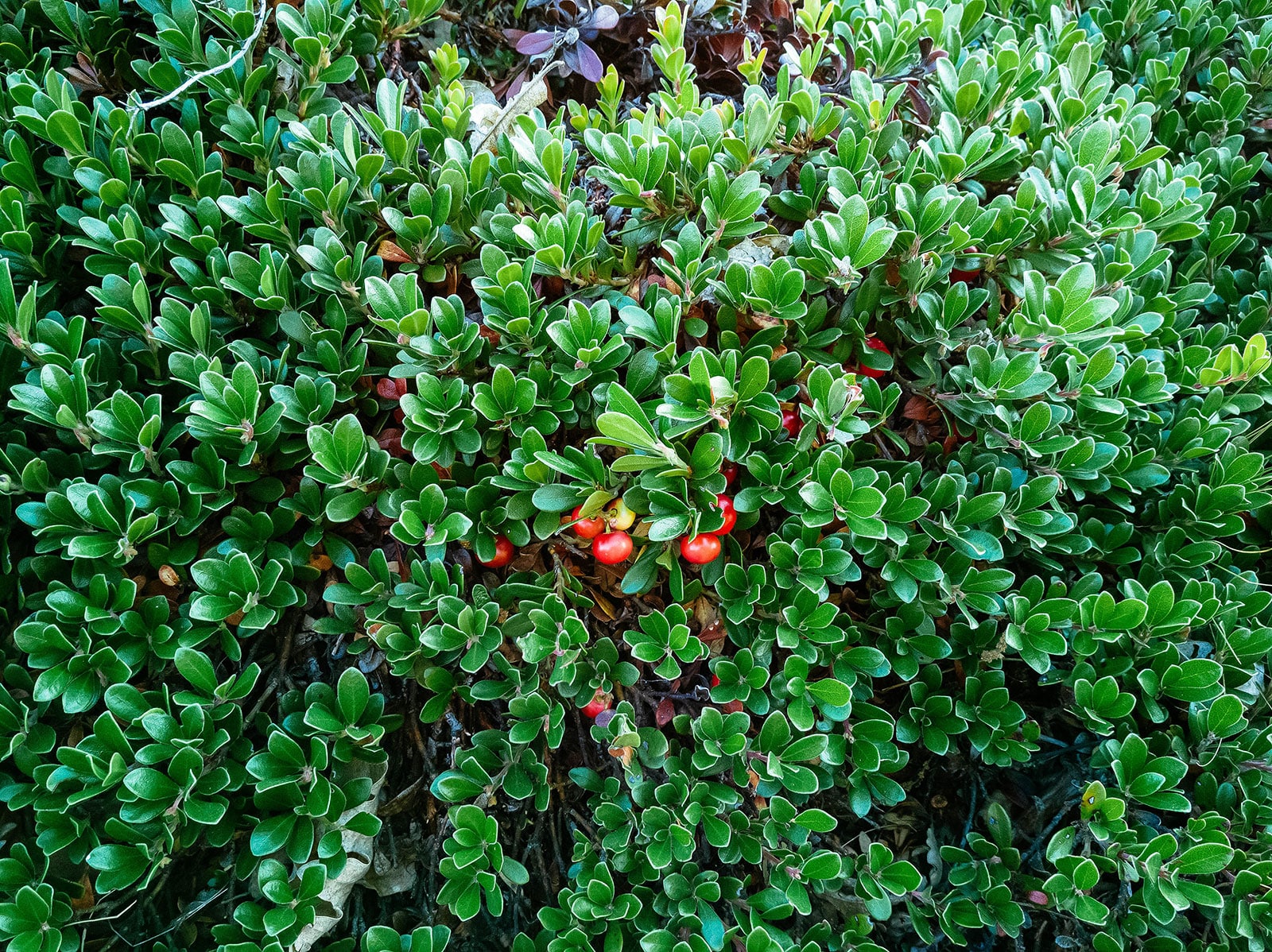
Need an evergreen ground cover that actually stays green in frigid temps? Look no further: bearberry is naturally found in the Arctic! so your garden should be no problem. This plant’s name was derived from the fact that bears love its bright red berries, but the cool thing is that they’re actually edible to humans too (great for jams, but not so much for fresh eating).
Bearberry, also known as kinnikinnik, makes a good groundcover choice for poor and rocky soil types where few other plants would thrive. It’s salt-resistant, making it suitable for coastal backyards, and can withstand occasional foot traffic.
You can place your bearberry plants in a spot that gets full sun to dappled shade. Although the species can be slow to establish itself, it can reach a height of around 12 inches and a width of up to 6 feet. Mature plants are fairly drought-tolerant.
- Soil type: Well-draining, sandy, acidic
- Light level: Full sun to partial shade
- Water: Water when dry
- Withstands foot traffic? Yes, but only light
Siberian cypress (Microbiota decussata)
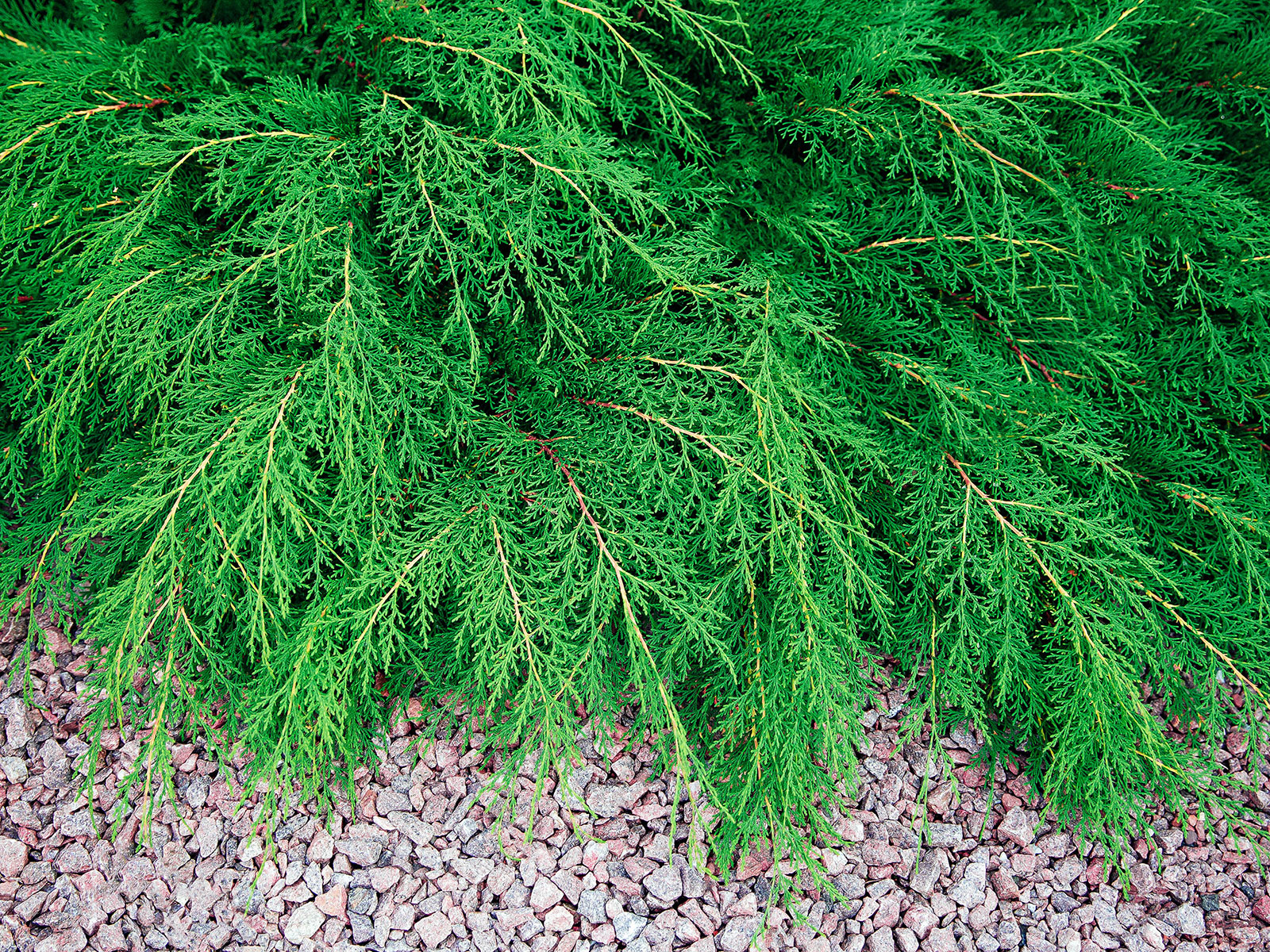
As the name suggests, this is another cold-hardy groundcover option. Siberian cypress is naturally found in the Sikhote-Alin mountains in eastern Russia, not exactly a hospitable natural habitat. That comes in handy for us, because it has evolved to need very little care.
Siberian cypress grows to a maximum height of around 12 inches tall and can grow up to 15 feet wide. It’s favored among gardeners for its delicate, feathery growth pattern and changes color from green to bronze between the summer and winter seasons.
The plant’s main demand is well-draining soil. It really doesn’t like swampy conditions! Rocky and poor soil types, however, are just fine. You can keep it in partial shade, though it’ll also tolerate full sun in cooler climates.
- Soil type: Well-draining, acidic to neutral
- Light level: Partial shade
- Water: Keep evenly moist
- Withstands foot traffic? No
Zones 4 and above
Dwarf yarrow (Achillea tomentosa)
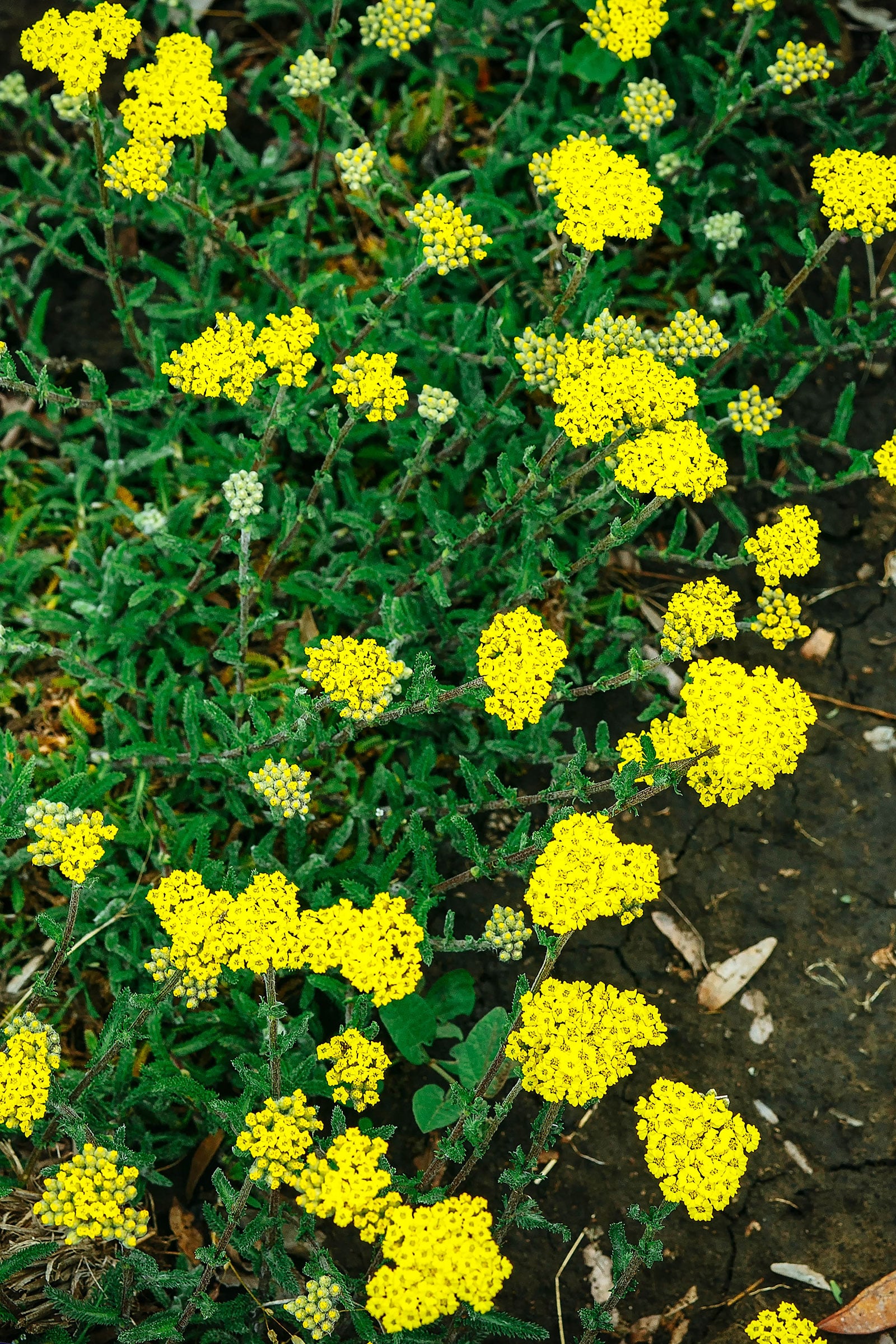
Dwarf yarrow (also known as wooly yarrow) is the low-growing version of common yarrow (which is also a great choice for an evergreen ground cover). But the dwarf variety grows only 6 to 8 inches tall with a spread of 8 to 12 inches across, making it more suitable for areas you might want to walk on.
The soft, lacy foliage feels good under foot and can handle moderate traffic, so it’s a nice lawn alternative if you’re looking for a drought-tolerant option that’s also attractive to pollinators. In early summer, clusters of canary yellow flowers top the dense mat of green leaves.
As a “wild” lawn, dwarf yarrow grows in clumps that spread easily for a more cohesive look. You can even “train” it to be more lawn-like by mowing it down to about 4 inches, where it’ll generally stay without much upkeep. Mowing your yarrow also keeps it from blooming, which is ideal if you want to walk on it (the dried-up flower stalks are not friendly to bare feet!).
- Soil type: Well-draining or sandy with low to average fertility
- Light level: Full sun
- Water: Highly drought-tolerant once established
- Withstands foot traffic? Yes
Creeping lilyturf (Liriope spicata)
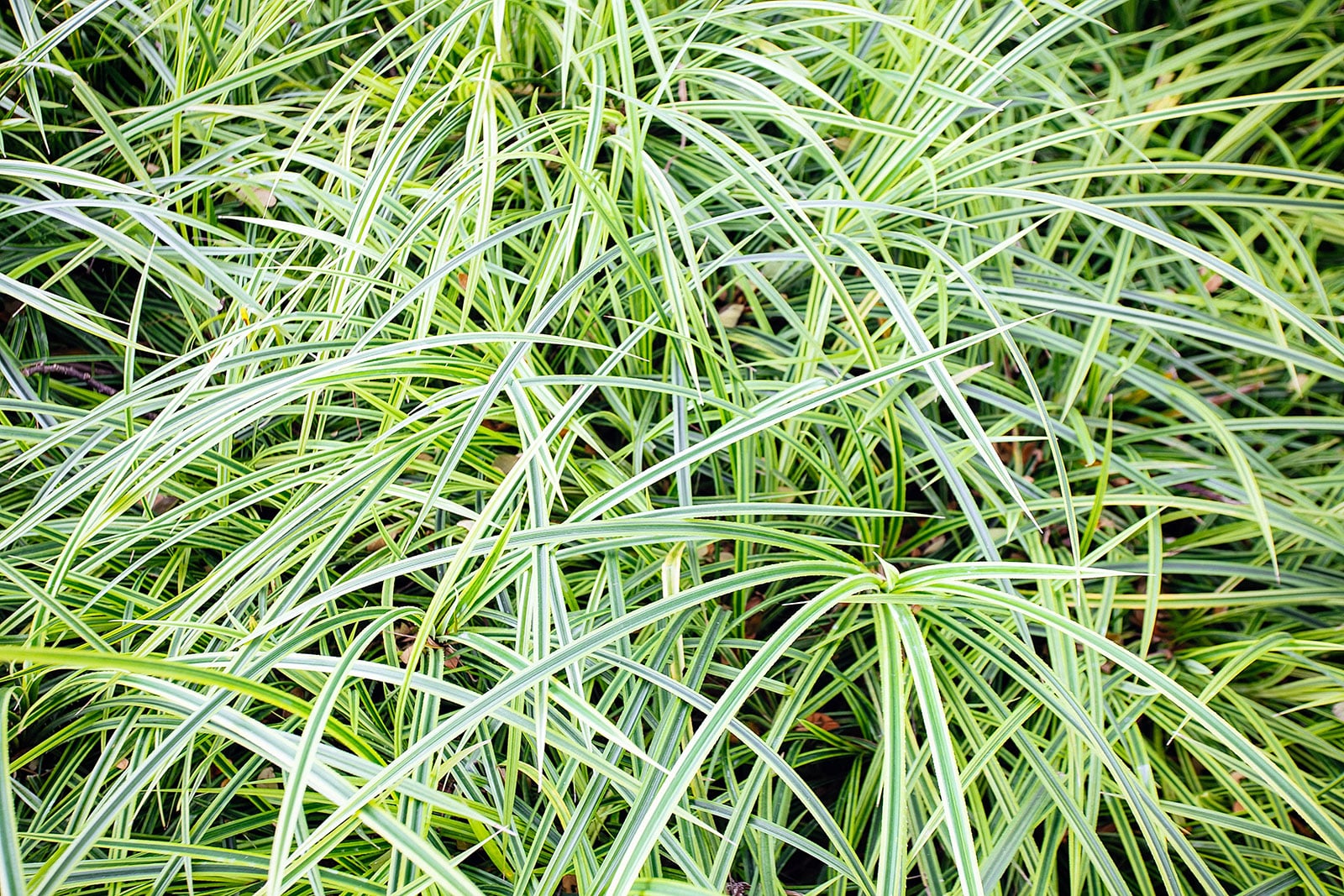
A highly popular groundcover choice for folks who like the grassy look, creeping lilyturf is technically not a grass—it forms part of the asparagus family Asparagaceae—but it sure does look like one. It only grows to around 15 inches tall, but thanks to its rhizomatous roots, it can spread very wide, especially if you help it along by replanting new clumps
Creeping lilyturf is native to Vietnam and China, where it can be found in the mountain understory. In your backyard, it prefers a slightly shaded spot and being planted in rich soil (or receiving regular doses of fertilizer during the growing season).
This ground cover is very easy to keep alive, but also highly vigorous, so be sure to only establish it where you’re sure you actually want it. When your creeping lilyturf goes dormant in winter, let the old leaves mulch the soil and then cut them back in spring to make room for new growth.
- Soil type: Well-draining, rich
- Light level: Half shade
- Water: Medium moisture
- Withstands foot traffic? No
European wild ginger (Asarum europaeum)

European wild ginger is many things: a great groundcover, attractive plant, and tolerant of low-light conditions, among others. What it is not, however, is ginger. It’s not even related to true ginger, but got its name thanks to the faintly gingery scent of its roots.
Naturally found throughout much of Europe, Asarum europaeum mostly grows as a ground cover in forested regions. It’s used to shady conditions, which makes it perfect for those spots in your garden where other ground cover plants may struggle to grow properly.
European wild ginger can grow to up to 6 inches tall and forms dense mats of pretty, patterned leaves. It thrives in a “foresty” soil type: rich with humus, lightly moist but well-draining, and slightly acidic to neutral in pH. A happy plant will produce dark red and rather hairy little blooms.
- Soil type: Well-draining, rich
- Light level: Half to full shade
- Water: Keep evenly moist
- Withstands foot traffic? No
Dwarf Japanese garden juniper (Juniperus procumbens ‘Nana’)
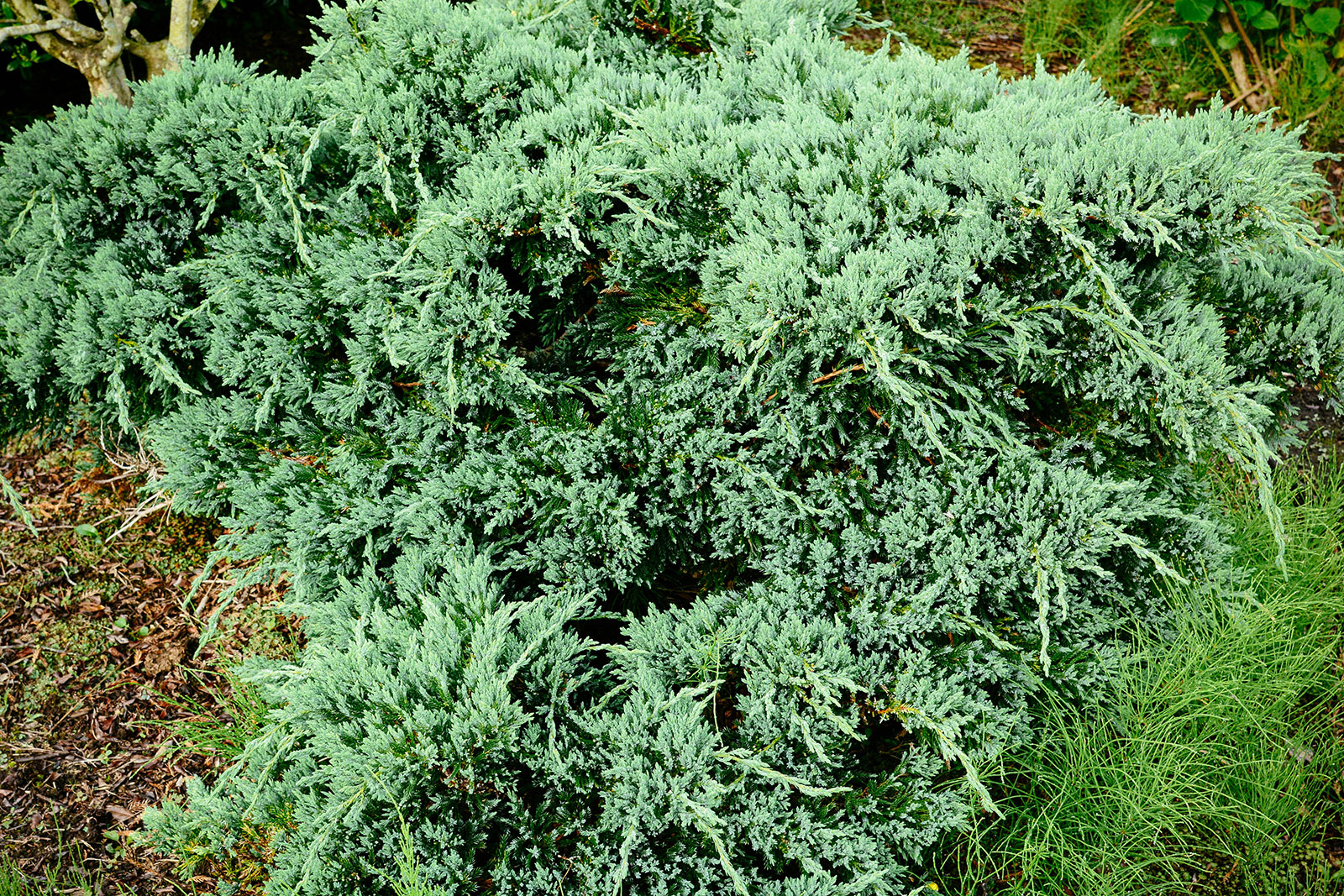
Most of us primarily know juniper as a shrubby, cone-shaped plant perfect for creating hedges, but we’ve already seen there’s also a creeping variety. Here’s another: Juniperus procumbens, the Japanese garden juniper, is always a rather low-growing plant, but the ‘Nana’ cultivar takes this to the extreme.
Growing to a maximum height of around 12 inches, dwarf Japanese garden juniper can quickly cover wide areas, with each shrub reaching up to 6 feet in width. It’s not fussy about soil type as long as drainage is excellent, and it’s pretty tolerant of dry spells. The species does need plenty of sun to thrive though.
Being a sturdy shrub, your garden juniper won’t mind the occasional foot traffic. Deer and other herbivores tend to leave it alone. This really is a great ground cover option, especially because it keeps its beautiful green color year-round!
- Soil type: Well-draining
- Light level: Full sun
- Water: Water when dry
- Withstands foot traffic? Yes, if it’s not daily
Japanese spurge (Pachysandra terminalis)
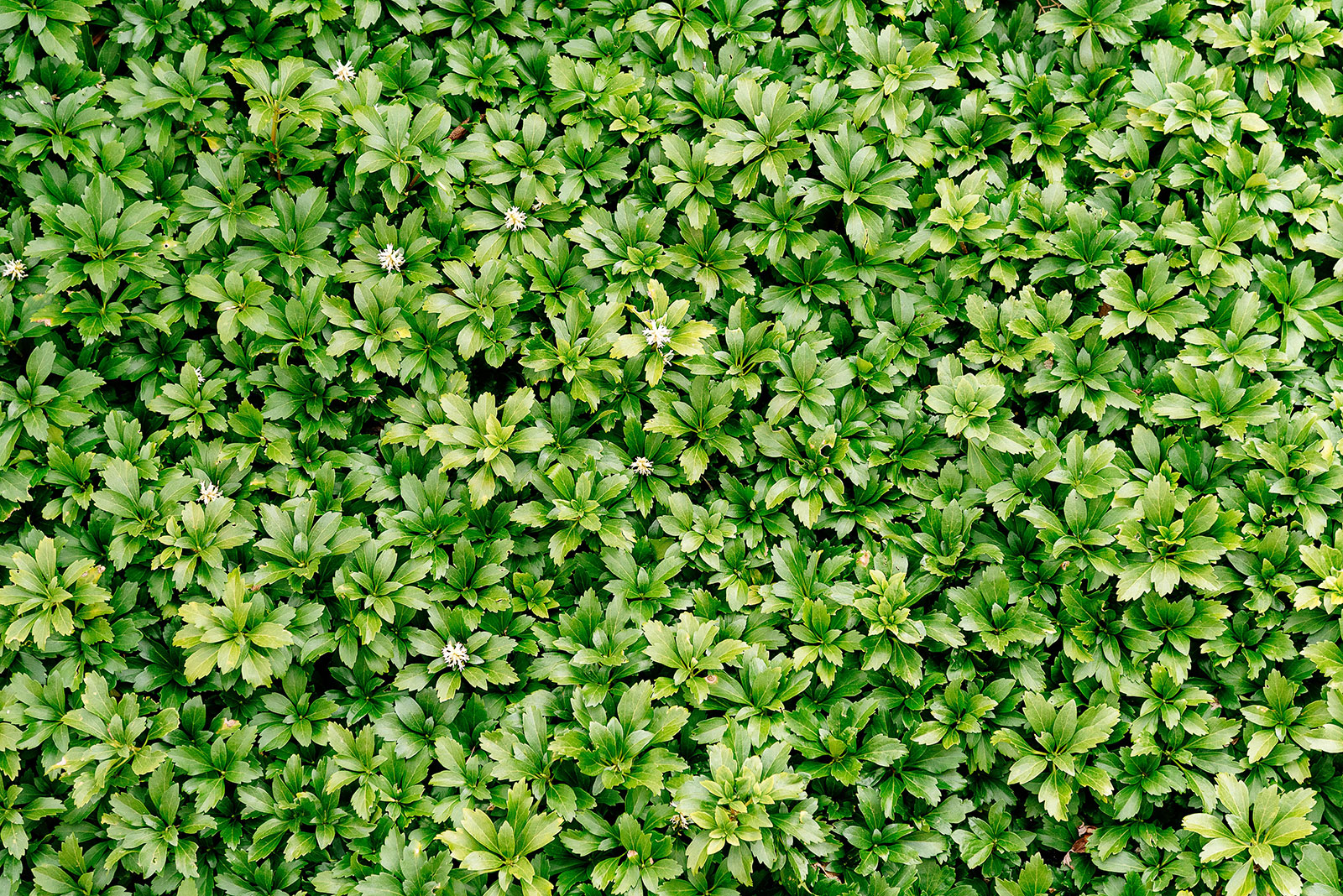
Also known as Japanese Pachysandra, a reference to its scientific name, Japanese spurge is a creeping perennial that can form incredibly tight mats. Perfect if you don’t want to be able to see even an inch of ground space and wish to choke out any and all signs of weeds!
Japanese spurge is a fast grower and quite vigorous, a characteristic that has led it to be classified as an invasive species in some US states. It’s a good idea to think carefully about where you plant it. If you manage to contain it properly, it makes for a nice and unfussy ground cover choice.
Growing up to 4 inches tall and naturally found as a forest understory plant, this shrubby evergreen grows best in shaded locations. It likes rich soils that stay lightly moist, although proper drainage is still important to prevent rot. The species can produce small white flowers.
- Soil type: Well-draining, rich
- Light level: Half to full shade
- Water: Keep evenly moist
- Withstands foot traffic? No
Christmas fern (Polystichum acrostichoides)

Prefer native plants? The Christmas fern is naturally found in much of the eastern USA, where it’s common in woodlands and along shaded streams. It’s a great choice if you don’t mind a taller ground cover plant (up to 2 feet) and have a nice and moist, shady spot to offer.
This lovely fern sports rich green, feathery fronds that don’t brown in winter, cheering up your garden even during the cold months. Yours will like rich soil that stays lightly moist, although it does tolerate dry spells better than a lot of other fern species.
Christmas ferns are unpalatable to deer and rabbits. The species is commonly used to prevent soil erosion and to maintain a healthy forest floor. Given some time, your ferns put out spores and naturally spread to form dense, showy patches wherever there’s shade. They look particularly decorative when grown under larger trees.
- Soil type: Rich, acidic to neutral
- Light level: Half to full shade
- Water: Keep evenly moist
- Withstands foot traffic? No
Zones 5 and above
Wall germander (Teucrium chamadrys)
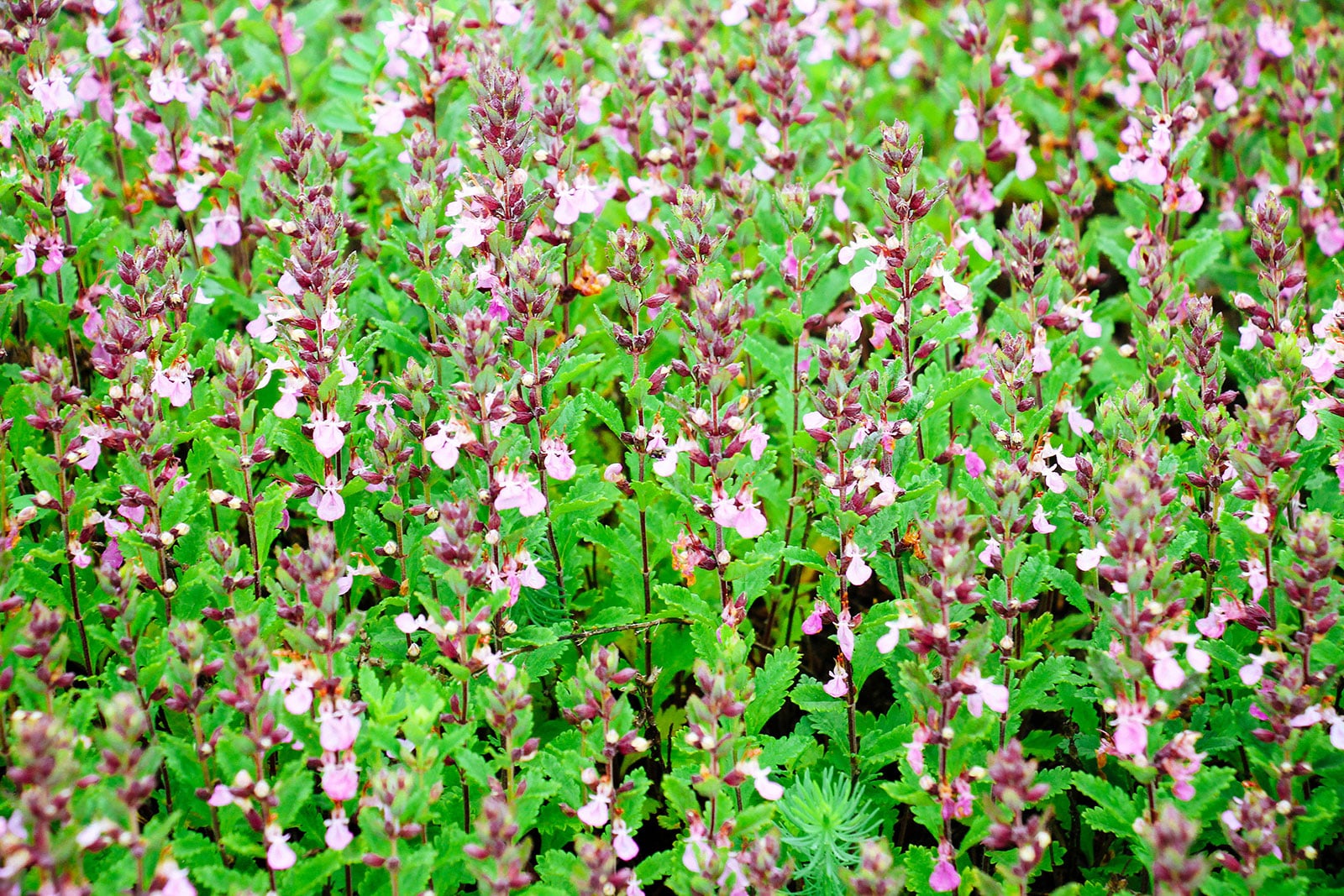
If you like pretty flowers, members of the mint family Lamiaceae always make a good choice. Teucrium chamadrys, better known as wall germander, is no exception. Native to the Mediterranean and the Middle East, this groundcover plant produces lovely small purple blooms that bees love during the summer months.
Wall germander grows to a maximum height of around 1 foot and is a quick grower. It likes plenty of sun, making it a good ground cover option for more exposed areas. Plant it in well-draining soil and water regularly, especially during summer.
Although this herb has fallen out of fashion as a health supplement because it was found to be hepatotoxic (causing liver damage), its leaves and stems smell really nice. You can save clippings to use for scented sachets or potpourris!
- Soil type: Well-draining
- Light level: Full sun
- Water: Water when dry
- Withstands foot traffic? No
Creeping phlox (Phlox stolonifera)
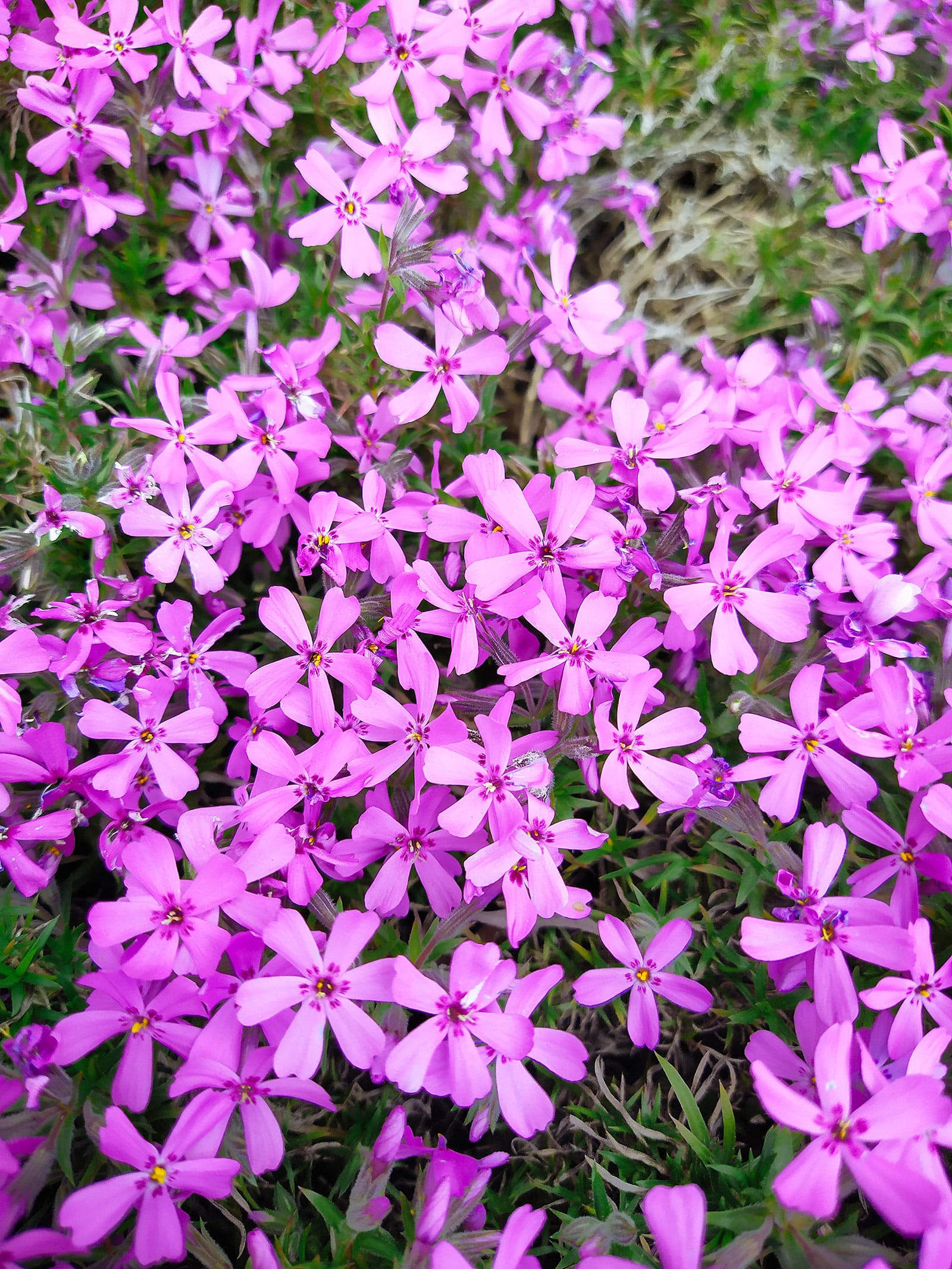
If the purple blooms of the aforementioned wall germander aren’t quite enough for you, maybe this one’s more to your liking! Creeping phlox produces dense mats of pretty and pleasant-smelling pink (cultivar ‘Pink Ridge’), purple (cultivar ‘Fran’s Purple’), or white (cultivar ‘Bruce’s White’) flowers during the spring and summer months.
Creeping phlox grows to a maximum height of around 12 inches and makes for an attractive ground cover option for areas that don’t get any foot traffic. It thrives in rich but well-draining soil and prefers a sunny spot in your garden.
I particularly like that creeping phlox is a native plant, naturally found in woodland across much of the eastern USA. It’s also a huge favorite among pollinators like butterflies. It may die back a bit during winter, but no worries—it’ll come back prettier than ever next spring.
- Soil type: Well-draining, rich
- Light level: Full sun to half shade
- Water: Keep evenly moist
- Withstands foot traffic? No
Wintercreeper (Euonymus fortunei)
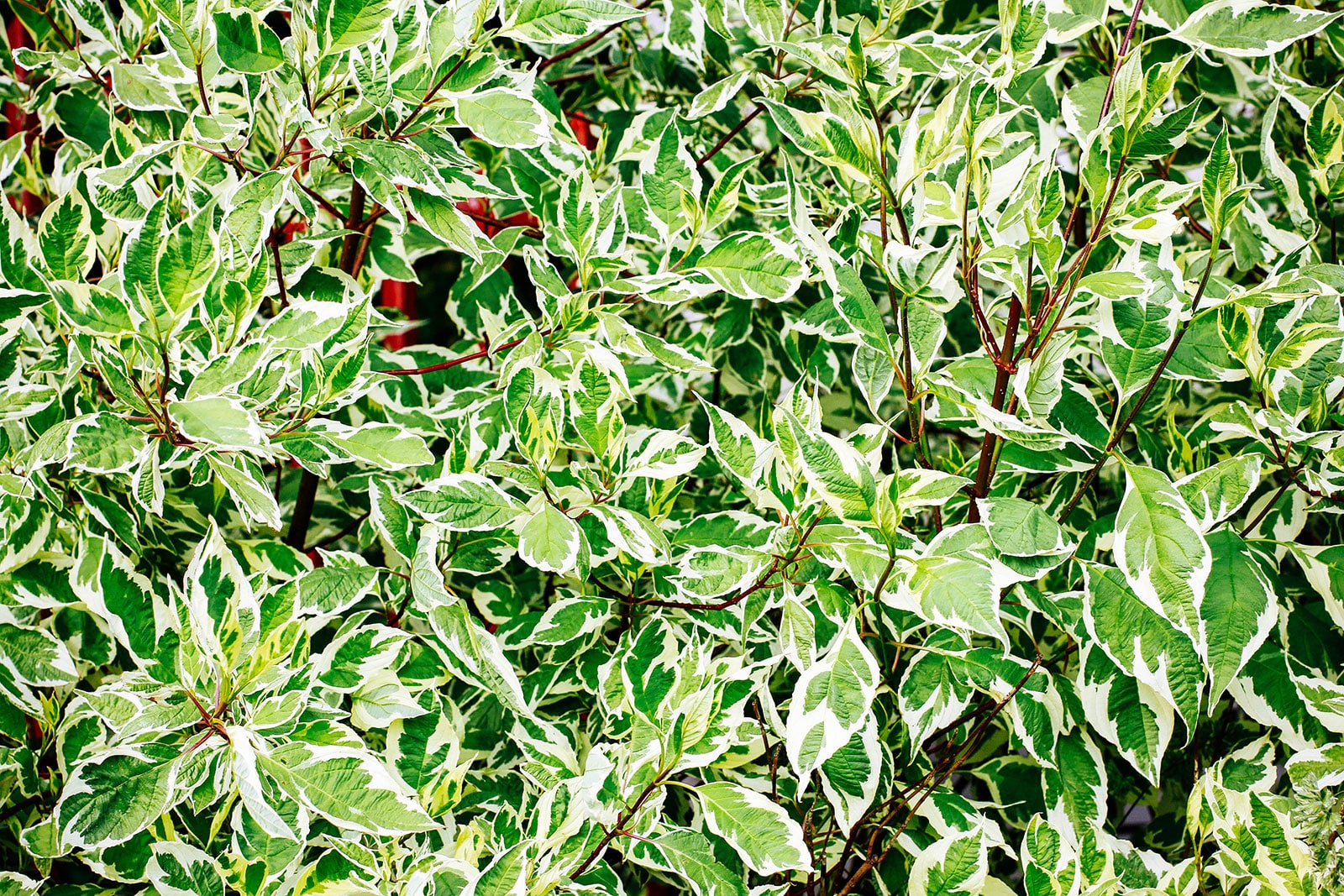
Also known as Fortune’s spindle, wintercreeper is a creeping plant naturally found in East Asia. It’s popular in the US as a ground cover or climbing plant, especially the variegated varieties with decorative gold-and-green foliage. If you let it climb, it can reach huge heights, but when used as a ground cover it only grows a few inches tall.
Wintercreeper is vigorous and not difficult to care for. It can quickly cover a large area, whether sunny or shaded, and isn’t too fussy about soil type and moisture levels. It even flowers, although the little white blooms aren’t considered all too spectacular.
Before you plant it in your garden, it’s important to consider that wintercreeper is considered an invasive species in North America. Be sure to keep yours contained so it doesn’t spread into your neighbors’ gardens and beyond!
- Soil type: Well-draining
- Light level: Full sun to full shade
- Water: Keep evenly moist
- Withstands foot traffic? No
‘Angelina’ stonecrop (Petrosedum rupestre ‘Angelina’)
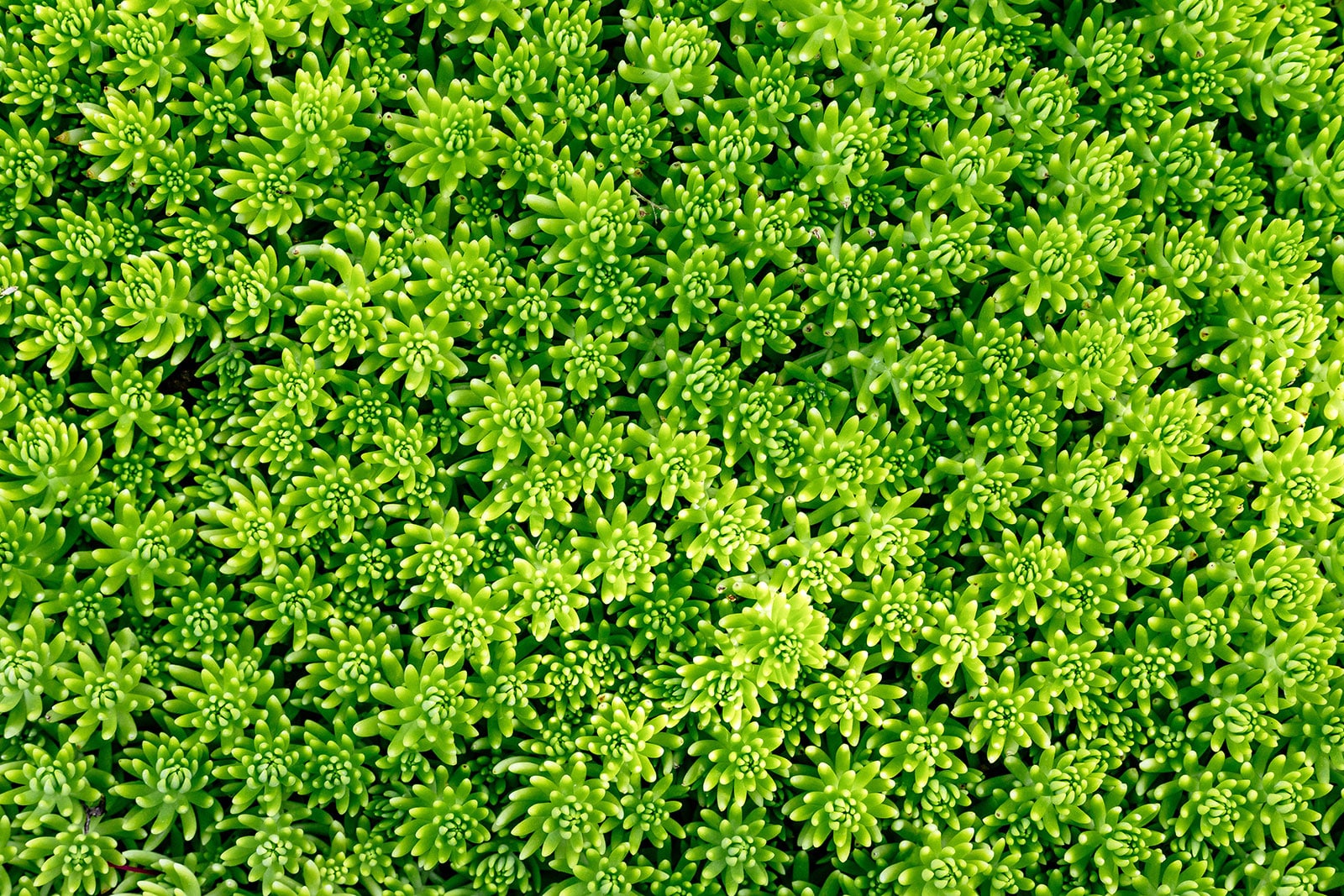
If you’re familiar with stonecrops, you’ll know that these sturdy succulents are pretty much foolproof. Unlike many other succulents, which prefer warm climates, stonecrops are mostly native to the Northern Hemisphere. This means they’re tough and relatively resistant to cold.
Petrosedum rupestre ‘Angelina’, a cultivar developed specifically for use as a ground cover, usually stays around 4 inches in height. It’s a quick grower, however, and yours will form wide, dense mats within a year or two with the right care.
Plant ‘Angelina’ in well-draining soil; it is still a succulent, after all. Rocky and relatively poor soil types are fine. The plants should get plenty of sun. Water regularly, especially in summer, but avoid overwatering since stonecrops are sensitive to root rot.
- Soil type: Well-draining, not too rich
- Light level: Full sun
- Water: Water when dry
- Withstands foot traffic? Very occasional
Dwarf periwinkle (Vinca minor)
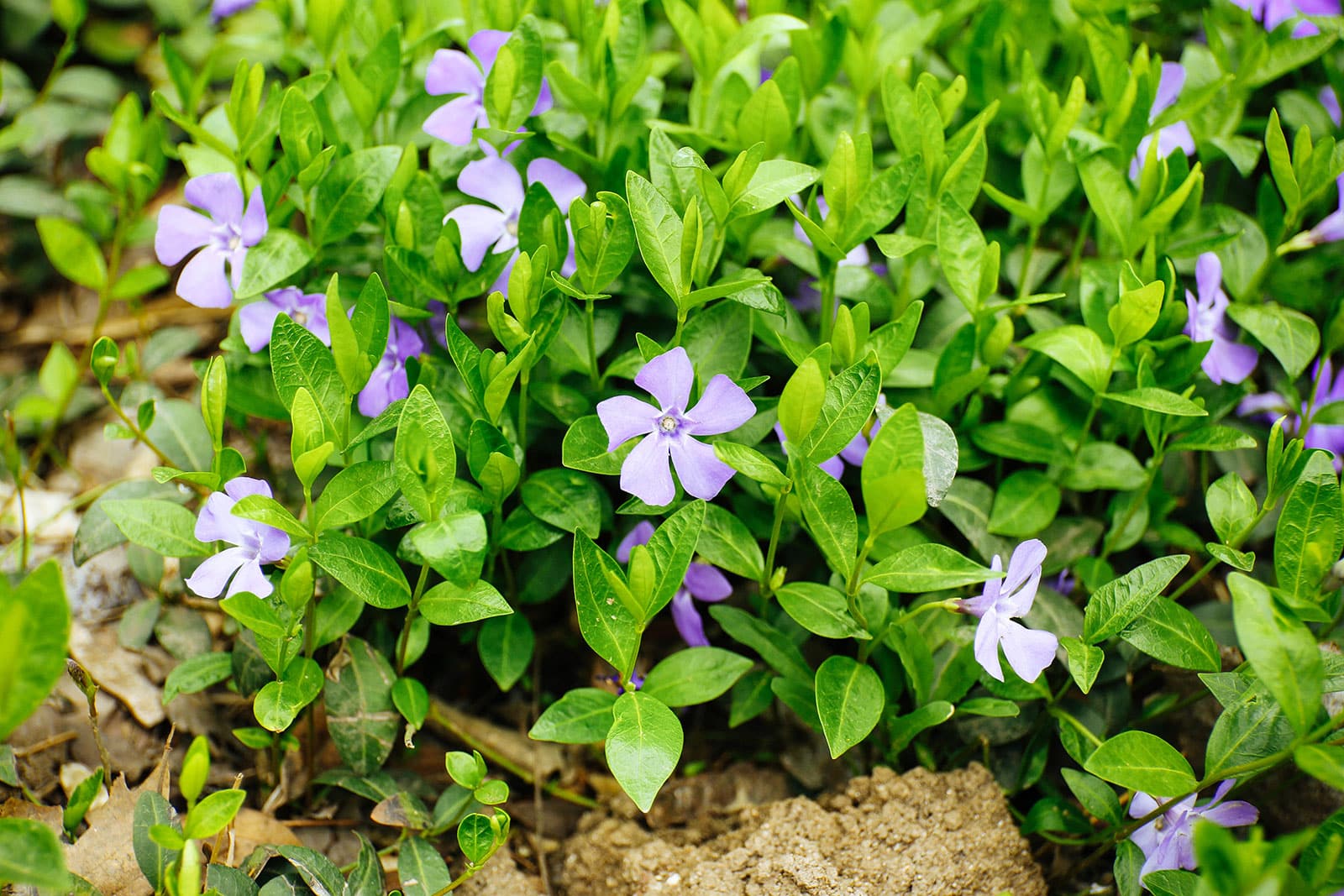
If you’ve ever visited a forest in Europe during springtime, you’ll be familiar with dwarf periwinkle. Normally an unassuming ground cover plant, it bursts into bloom when temperatures rise, forming thick mats of gorgeous little blueish-purple blooms.
Luckily for us, dwarf periwinkle also thrives in our North American gardens. Although you need to make sure you want this species in your garden in the long run before you plant it (it’s difficult to remove once established and considered invasive in some places), it makes for a lovely groundcover plant that only reaches around 6 inches in height.
This is a versatile plant that can tolerate a wide range of light conditions. It likes well-draining soil and regular waterings. Keep an eye out for cultivars like the variegated ‘Argenteovariegata’, the white-flowered ‘Gertrude Jekyll’, and the double-petaled ‘Azurea Flore Pleno’.
- Soil type: Well-draining
- Light level: Full sun to full shade
- Water: Keep lightly moist
- Withstands foot traffic? No
Creeping Oregon grape (Mahonia repens)
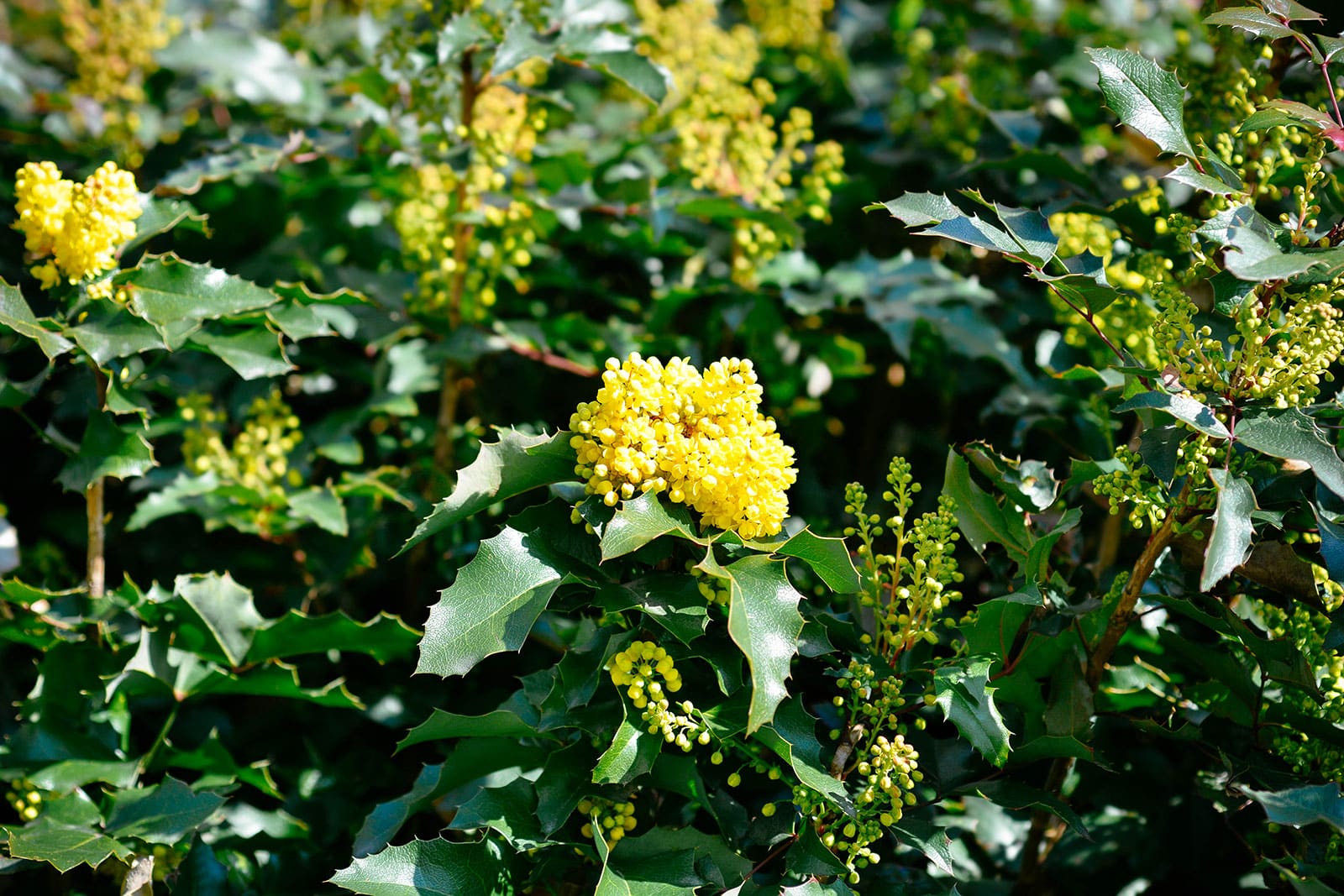
The only thing better than a nice ground cover plant is a nice edible ground cover plant! Although the berries produced by the creeping Oregon grape are very sour (and taste nothing like grapes) when eaten raw, they’re perfectly suitable for use in jellies and jams. My kids consider them a fun “urban forage” when we’re out walking in our local neighborhoods!
This sprawling evergreen grows to a maximum height of 4 feet and is known not just for its berries, but also its decorative yellow flowers. Originally from the western USA and parts of western Canada, it’s considered unfussy. Sun or shade, rain or drought—Mahonia repens doesn’t care. The only thing that bothers it is excessive heat.
You can plant your creeping Oregon grape in normal to well-draining soil, preferably lightly acidic to neutral. As an added bonus, the berries are loved by various bird species, so this is a good plant to use if you’d like to attract more wildlife to your backyard.
- Soil type: Well-draining, acidic to neutral
- Light level: Full sun to half shade
- Water: Keep lightly moist
- Withstands foot traffic? No
Zones 6 and above
Creeping raspberry (Rubus rolfei)
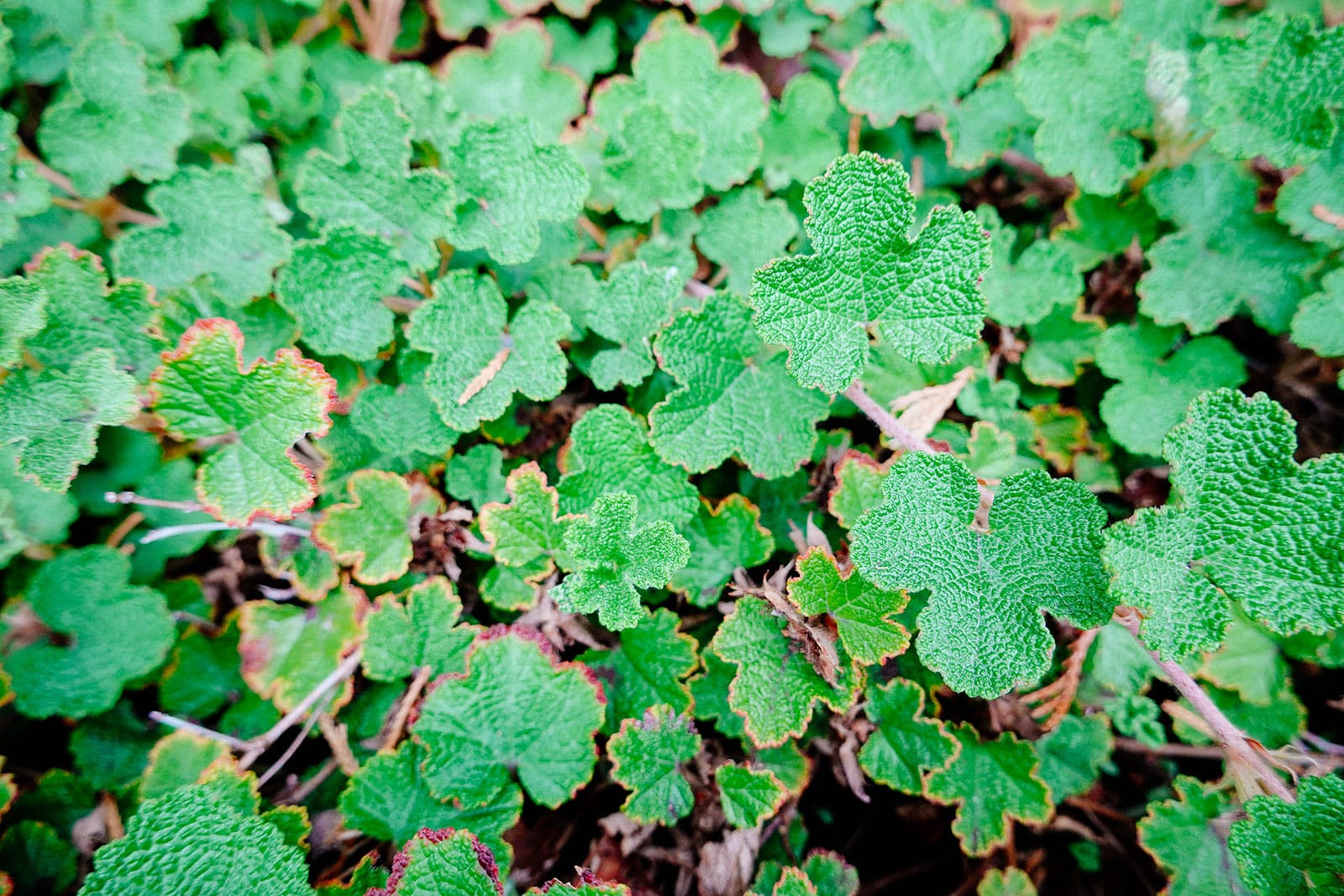
Here’s another ground cover plant with edible berries! Although the creeping raspberry’s yellow-orange fruits aren’t very abundant or flavorful, you can technically eat them as they are or use them to make jams and preserves.
Originally from Taiwan, where it grows in subtropical regions at higher altitudes, creeping raspberry also does well in our backyards in USDA Zones 6 and up. It’s low-growing, usually reaching no more than 1 foot in height, and can also creep up walls and rocks. It produces small white flowers in spring and summer.
One thing I especially like about this ground cover plant is that it can handle occasional foot traffic. It’s also easy to care for; just give it a sunny to half-shaded spot with rich but well-draining loamy soil and water regularly until it’s established (or if you live in a dry climate).
- Soil type: Well-draining, rich
- Light level: Full sun to half shade
- Water: Keep lightly moist
- Withstands foot traffic? Yes, if it’s occasional
Common lilyturf (Liriope muscari)
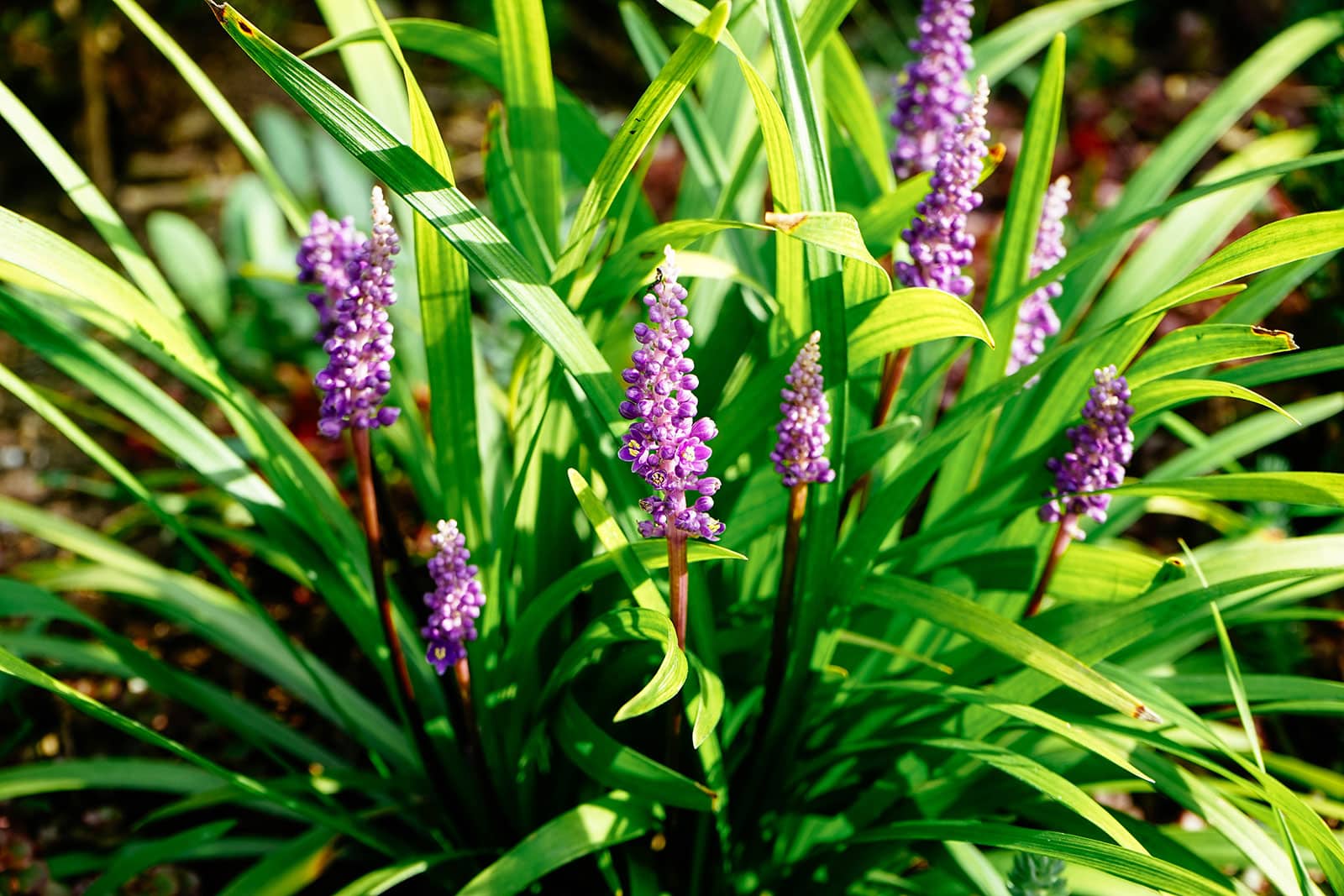
At 1 1/2 feet, it’s a good bit taller than its previously mentioned cousin, creeping lilyturf, but common lilyturf (Liriope muscari) is still a popular ground cover choice for gardens and parks due to its decorative grassy evergreen foliage and pretty purple autumn blooms.
While this plant forms part of the forest understory in its natural habitat, it doesn’t necessarily prefer shade—it does fine in full sun too. It looks particularly nice when planted around trees or walkways. The species thrives in rich but well-draining and slightly moist soil.
There are various common lilyturf cultivars to choose from, including a variegated version with striped leaves (called ‘Variegata’). You can also go for pink flowers (‘Pink Pearl’), extra-long leaves (‘Big Blue’), or a pretty variety called ‘Silvery Sunproof’ (whose name reflects its primary characteristics well!).
- Soil type: Well-draining, rich
- Light level: Full sun to full shade
- Water: Keep evenly moist
- Withstands foot traffic? Yes, if it’s occasional
Dwarf mondo grass (Ophiopogon japonicus ‘Nanus’)
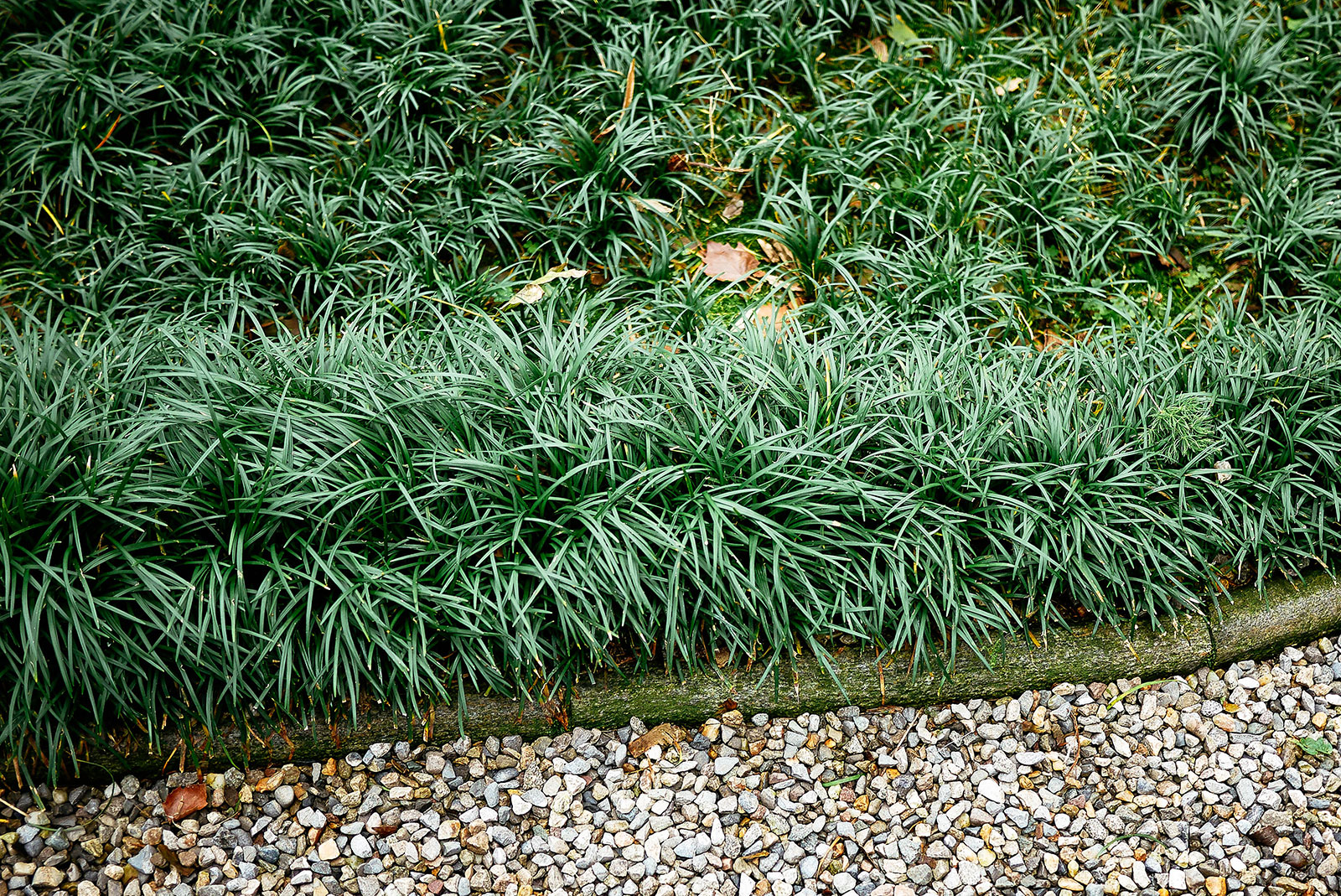
If you like grassy plants, here’s another attractive ground cover option: Ophiopogon japonicus ‘Nanus’, better known as dwarf mondo grass. An evergreen with lush, dark green foliage, it stays much smaller than normal mondo grass, reaching only around 6 inches in height.
This small clumping plant grows in small tufts of around 6 inches wide that can eventually carpet large areas. It doesn’t mind regular foot traffic and can be grown in normal, well-draining soil. Salt doesn’t tend to be an issue, making this a good choice for the coastal garden.
Mondo grass isn’t fussy about light levels, growing well in full sun to partial shade. While this cultivar is relatively drought-tolerant, you should ideally keep the soil lightly moist.
- Soil type: Well-draining, rich
- Light level: Full sun to half shade
- Water: Keep evenly moist
- Withstands foot traffic? Yes
Black mondo grass (Ophiopogon planiscapus ‘Nigrescens’)
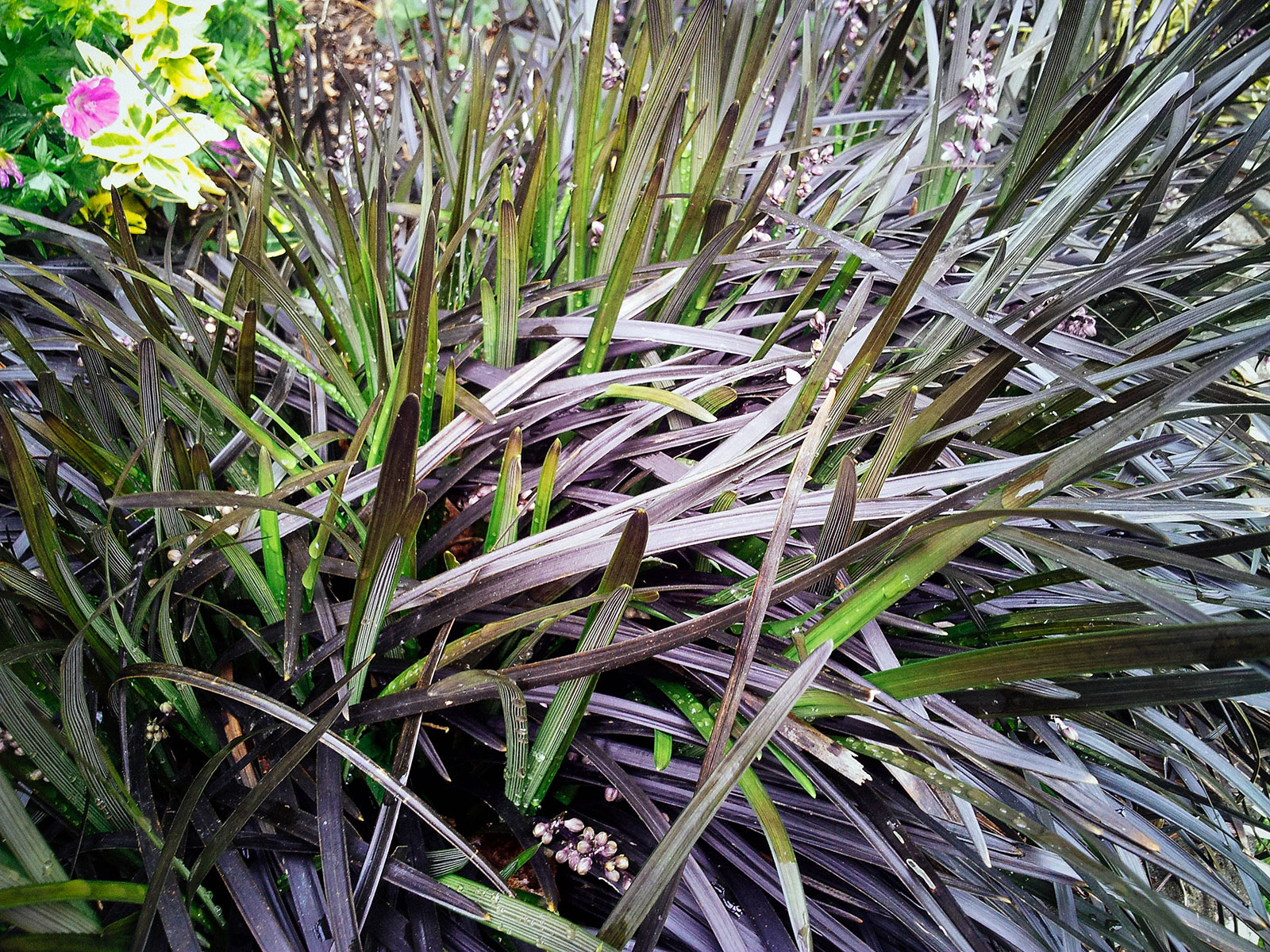
Okay, one more grass option! There are a few different species of mondo grass, and one of the more decorative is Ophiopogon planiscapus ‘Nigriscens’. Better known as black mondo grass, this one’s easy to recognize by its dramatic greenish-black foliage (which looks outstanding against an otherwise all-green landscape).
Although it’s just as durable and easy to care for as its aforementioned cousin, keep in mind that black mondo grass is not a dwarf variety and therefore grows a bit larger—up to 8 inches high and 12 inches wide. This plant spreads slowly, but can eventually form a dense mat. You can speed things up by dividing the clumps.
Quick Tip
Don’t confuse mondo grass of the genus Ophiopogon with Liriope, which is also mentioned on this list. Both belong to the family Asparagaceae and are sometimes called lilyturf, but they’re not the same.
- Soil type: Well-draining, rich
- Light level: Full sun to half shade
- Water: Keep evenly moist
- Withstands foot traffic? Yes, if it’s occasional
Creeping thyme (Thymus praecox)
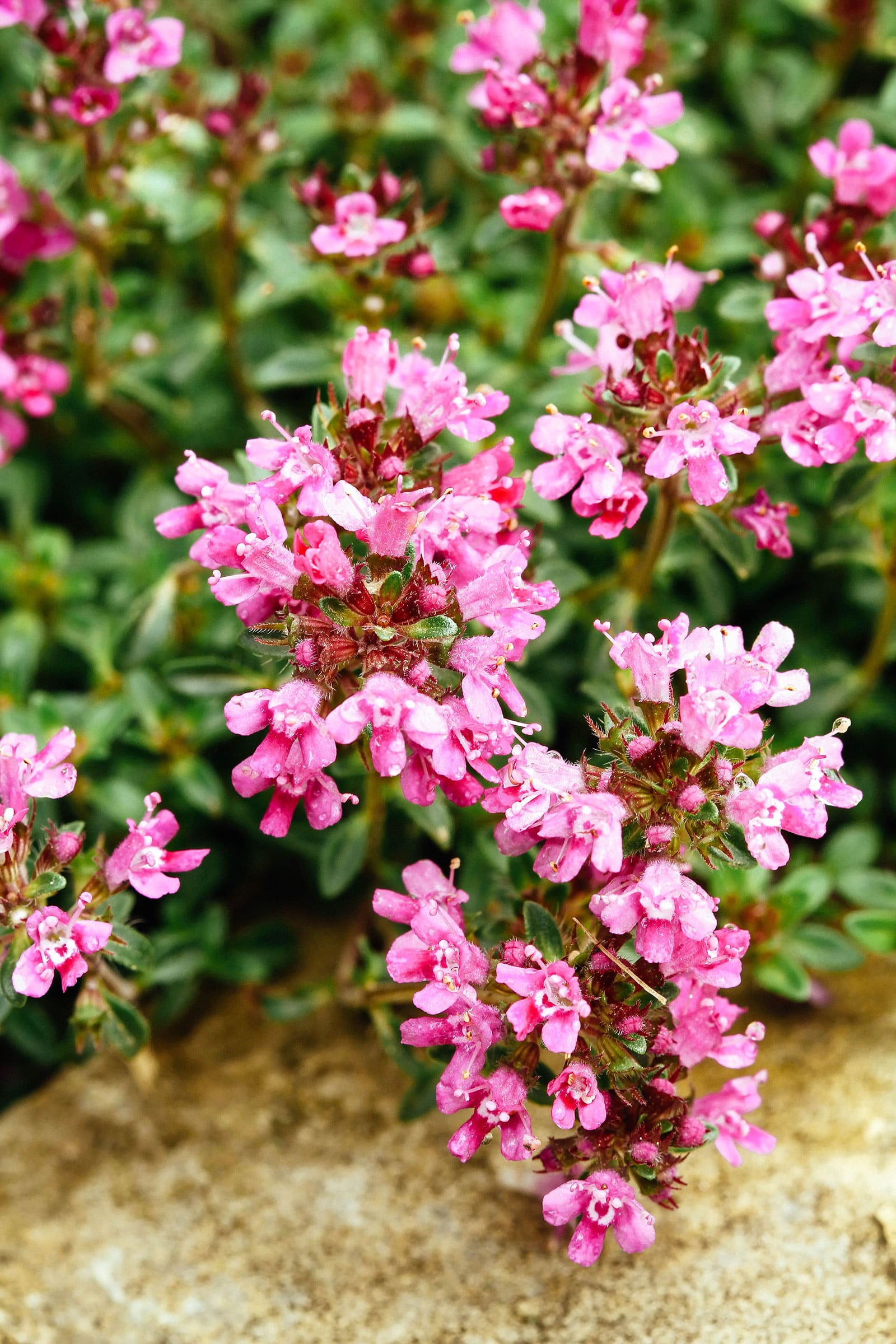
One of my absolute personal favorites on this list, creeping thyme is a ground cover that simply has it all. Not only is it low-growing (just 1 to 2 inches tall) and very densely carpeting, but as a member of the mint family, it’s also a beautiful bloomer that can cover your garden in a sea of pink that bees just adore.
Read more: Plant these bee-friendly flowers in your garden
That’s not all. Creeping thyme is also very tolerant to foot traffic! It’s sometimes said that it grows back better if you step on it regularly, and while I don’t know if that’s true, I do know that it emits an amazing scent when crushed.
I personally can’t help but ruffle my hand through the leaves every time I’m near it, and it’s a staple in my perennial herb garden. (Mine easily stays green in my Zone 5 microclimate since I cover my bed with frost cloth in winter.)
Naturally found in Europe, creeping thyme is pretty hardy. It likes lots of sun and doesn’t need much water. Poor, rocky soil is fine too; the species isn’t used to growing in a nutrient-rich medium. Do keep in mind that it’s considered invasive in parts of the USA.
- Soil type: Well-draining, not too rich
- Light level: Full sun
- Water: Water when dry
- Withstands foot traffic? Yes
Rock rose (Helianthemum nummularium)
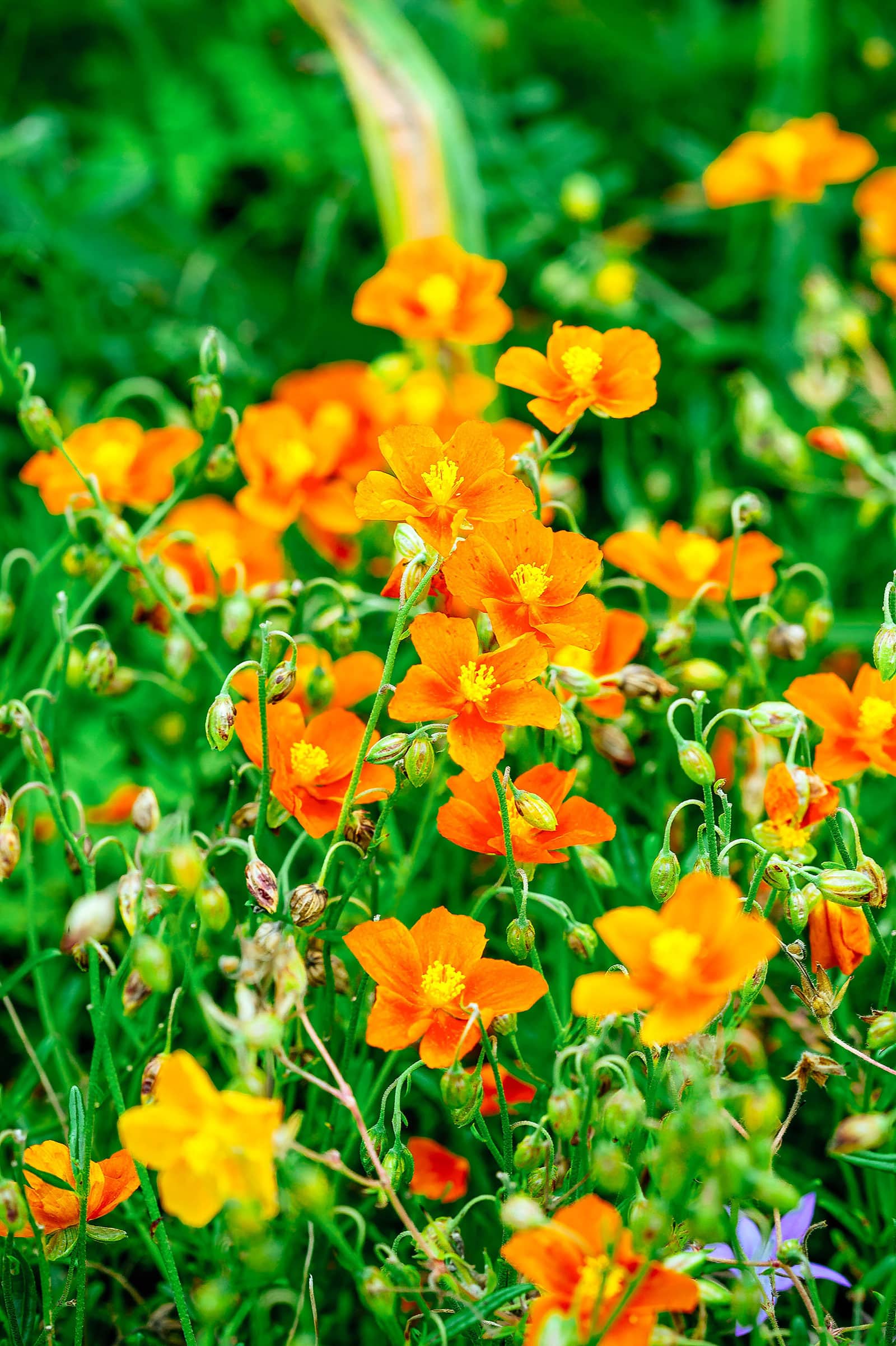
Let’s close out the list with some more pretty flowers! Wild rock rose produces yellow flowers, but there are a number of different cultivars that bloom in various shades of orange, white, pink, red, and more.
Another European native, this species isn’t an actual rose of the family Rosaceae. It belongs to its own small family, the Cistaceae or rock roses, which share common characteristics like a preference for plenty of sun, a tolerance to drought, and the ability to grow in poor soils.
Helianthemum nummularium is the most commonly grown rock rose. A low-growing sub-shrub, it works well as a ground cover thanks to its maximum height of around 12 inches. It’s evergreen and tolerant of saline soil.
- Soil type: Well-draining, not too rich
- Light level: Full sun
- Water: Water when dry
- Withstands foot traffic? No
















Hi Linda,
My back lawn was so weedy I dug it up and replaced it with a couple of inches of DG and a couple inches tree bark/ mulch. Now I have decided to use beds that are octagonal) from Costco) to grow tomatoes, kale, komatsuna, sugar snap peas and others that we like. My question is, will anything grow in the aisles, between the beds. Sweet alyssum grew for awhile even tho it was barely watered. Do I need to dig out the paths and fill with dirt before anything will grow? There won’t be heavy foot traffic, but some, when I tend to my garden, including deadheading,and removing dried leaves and of course, harvesting. What do you suggest I plant as ground cover for these areas?
Thank you,
Beverly
My favorite ground over is a succulent like Angelina. I will need to research what it actually is this year–my mother gave me a handful from her garden about 30 years ago and I can’t remember what it’s called…It has an adorable yellow flower that carpets everything in the spring, and if it gets to leggy just just pinch it back or pull it out and toss it on a bare soil spot to regrow. It keeps my tomato and peppers beds almost completely weed free without bothering the veggies! I have space for creeping thyme–that’s next to try!
Thanks for the wonderful article on ground covers. As a gardener living in the western Washington, where concern for wildfire is growing by leaps and bounds, I would love to see an article on plants that are fire resistant, that can safely be grown near houses (though not right up to the walls, naturally).